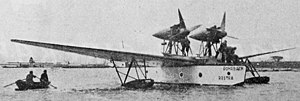Rohrbach Ro XI
| Rohrbach Ro XI Rostra | |
|---|---|

|
|
| Type: | Freight and transport flying boat |
| Design country: | |
| Manufacturer: | |
| First flight: |
October 30, 1928 |
| Production time: |
1928 |
| Number of pieces: |
1 |
The Rohrbach Ro XI Rostra flying boat was built at the end of the 1920s and was to be used as a long-haul freighter on the transatlantic routes of Luft Hansa .
development
The Ro XI was built in 1928 using assemblies from the Robbe II flying boat , which was damaged by a broken propeller during a test flight for a planned Atlantic crossing in an east-west direction in autumn 1927 and subsequently disarmed. The hull boat was taken over from him. The structure was a new construction with a larger span and a higher surface loading to increase the payload . The two BMW engines with propellers in pressure design were exchanged for two Gnôme-Rhône drives with pull propellers. The flight test was carried out at the E -stelle See in Travemünde and began on October 30, 1928. It was satisfactory; only the rudder had to be increased due to insufficient effectiveness. For the transatlantic traffic, in addition to the freight version, a version for the transport of five passengers was planned, the range of which, however, was limited to 2300 km due to the reduced fuel volume. During the testing, however, there was never such a conversion. For reasons not known, after the end of the tests neither a handover to Luft Hansa nor a registration of the only built Rostra took place .
construction
The Ro XI is a cantilevered shoulder wing made of metal.
- hull
The hull boat is designed in two stages and strongly keeled. It is divided into several sections by bulkheads , which give the flying boat buoyancy even in the event of water ingress of up to 5 m. The closed, two-seater cab is located in front of the leading edge of the wing. Behind it is the cargo hold, equipped with a reinforced floor and lashing fittings, to which the crew cabin for the radio operator is connected.
- Structure
The wing consists of the rectangular middle section, on which the engines are also placed on struts, and the tapering, slightly swept outer wings with a slight V-position, in which the fuel tanks are housed.
- Tail unit
The elevator and rudder units are trapezoidal in shape, with the elevator set high, protected against splashing water, and supported with I-posts towards the fuselage.
- Floating mechanism
To ensure stability on the water, the Rostra has two support floats attached to both sides under the outer wings by struts, which, in contrast to earlier Rohrbach flying boats, are arranged a little further from the hull.
Technical specifications
| Parameter | Data |
|---|---|
| crew | 3 |
| Passengers | 5 (optional) |
| span | 26.90 m |
| length | 15.60 m |
| height | 6.30 m |
| Wing area | 77.00 m² |
| Wing loading | 97.4 kg / m² |
| Preparation mass | 4340 kg |
| Payload | 4060 kg (freight version) |
| Takeoff mass | 8400 kg (freight version) 7500 kg (passenger version) |
| drive | two air-cooled nine-cylinder - four stroke - radial engines with fixed four-bladed propellers |
| Type | Gnôme-Rhône Jupiter VI 9 |
| Starting power continuous power |
610 HP (approx. 450 kW) each 450 HP (approx. 330 kW) each |
| Top speed | 208 km / h |
| Cruising speed | 158 km / h |
| Service ceiling | 3000 m |
| Range | 3800 km (freight version) 2300 km (passenger version) |
| Flight duration | 23 h (cargo version) 13.8 h (passenger version) |
literature
- Hans-Jürgen Becker: Seaplanes - flying boats, amphibians, float planes . In: German aviation . tape 21 . Bernard & Graefe, Bonn 1994, ISBN 3-7637-6106-3 , pp. 133 and 137 .
- Fred Gütschow: The German flying boats . Motorbuch, Stuttgart 1978, ISBN 3-87943-565-0 , p. 271 ff .

